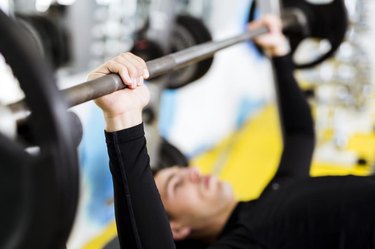
For guys in particular, chest muscles are a high priority when embarking on a fitness regimen and the bench press is shown to be the fast track to strong chest muscles. In a study ranking the most effective chest exercises, the American Council on Exercise ranked it number one.
Bench presses may also be near the top of the list for post-workout soreness. That's especially true if you're new to working out or are resuming a fitness program after a long spell being sedentary. Activating muscle groups in the shoulders, upper arms, chest and back , bench press works it all -- and can also make it all sore. Understanding more about how your muscles respond to intensive exercises such as bench press may not entirely help you avoid soreness, but could help you avoid injury and being sidelined from overdoing it.
Video of the Day
Video of the Day
Read More: Dumbbell vs. Bench Press
Welcome to DOMS
Why can bench pressing cause such sore muscles? It's explained by an acronym, DOMS -- which stands for delayed onset muscle soreness. Setting in from 24 to 48 hours after a workout, DOMS is the hurt that goes into the proverbial "No pain, no gain" formula. Symptoms usually resolve after 96 hours.
Everybody has experienced DOMS whether we or not we knew it had a name. The mechanisms that bring it on aren't clearly understood, but it's generally agreed that two or more of several things are at work. Muscle spasm, lactic acid, muscle damage, connective tissue damage and inflammation may all contribute.
According to University of New Mexico exercise researcher Len Kravitz, DOMS is mostly caused by so-called "eccentric" exercises, such as weight training exercises like the bench press that cause the muscles to elongate under tension. The resulting inflammation causes the release of metabolic waste products that irritate nerve endings, causing pain.
DOMS vs. Muscle Strain: Know the Difference
DOMS itself is not an injury, but it is possible to injure yourself while bench pressing by attempting too much weight or pressing with bad form. A muscle strain is an actual tear in the muscle, and it's important to know the difference between a strain and DOMS. While it's safe to exercise a muscle experiencing DOMS, exercising a strained muscle, especially with weights, can severely aggravate the injury.
Treatment
Treatment is similar for both DOMS and muscle strains: ice, anti-inflammatory drugs such as aspirin, ibuprofen or naproxen and massage can be helpful. However, while stretching may alleviate symptoms of DOMS, it may not be the best thing for a strained muscle.
Prevention: the Importance of Warming Up
Most people have an idea that warming up before working out is a good thing, but they may not know how to go at it correctly. Static stretching, which means maintaining a stretch for 20 to 30 seconds is commonly practiced, but it's actually the wrong way to go. Static stretches tell your muscles to relax when they should be preparing to activate.
Instead, go for dynamic stretches. That means putting your joints through a full range of motion with no resistance, rather than holding tight. Appropriate dynamic stretches for bench pressing include arm circles, shoulder and neck rolls and wrist rotation.
Jogging or time spent on the treadmill might help too; aerobic exercises speed up the metabolism gradually and raise muscle temperature, increasing suppleness and making the muscles less prone to injury. It takes about 10 to 20 minutes of moderate exercise to warm up the muscles.
Read More: Major Muscle Groups Used in the Bench Press
- ACE Fitness: The 3 Most Effective Chest Exercises
- ACE FITNESS: Myths and Misconceptions: Muscle Soreness
- University of New Mexico: Treating and Preventing DOMS
- ACE Fitness: Common Mistakes People Make When Warming Up
- Journal of Human Kinetics: The Effect of Warm-Up and Cool-Down Exercise on Delayed Onset Muscle Soreness in the Quadriceps Muscle: a Randomized Controlled Trial